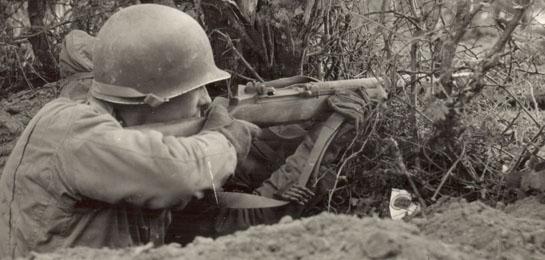We may earn revenue from the products available on this page and participate in affiliate programs. Learn More ›
When most people think ‘American’ they think baseball, apple pie, and accurate rifles. Or, at least they should. Well-made rifles (and of course the men and women who fired them) not only earned this country its freedom, but they’ve fought to defend it for centuries.
So, this Fourth of July we give a tip of the hat to seven rifles that helped win and defend our country’s independence.
1) Kentucky Long Rifle
The Kentucky long rifle was actually created in eastern Pennsylvania in the early 1700s. The gun, which typically fired .40 to .50 caliber lead balls, had a 40-inch (or longer) rifled barrel, which made it far more accurate than the smoothbore muskets of the era.
It earned its name after frontiersmen used it to pioneer the Kentucky wilderness. But the gun reached its legendary status during the Revolutionary War when George Washington recruited special ranks of frontiersmen to pick off redcoats at a distance with their Kentucky rifles. Depending on the marksman, the rifles were deadly out to 200 yards. The British ‘Brown Bessies’ were effective to only about 60 yards.
2) Springfield Model 1861

This rifled muzzleloader helped free the slaves and save he Union. About 700,000 of these .58 caliber guns were produced and issued to Union troops after the Civil War began. The rifle used more reliable percussion caps to ignite the powder charge instead of flintlocks and sported a 40-inch barrel. Some Confederate troops also used the rifle, but most ended up with the Pattern 1853 Enfield.
Well-trained troops could fire three rounds per minute and maintain accuracy out to a few hundred yards. Civil War firefights usually broke out at closer ranges, so a fast rate of fire became more critical than long-range accuracy.
3) M1903 Springfield

The rifle that took down the Central Powers has strong ties to the German Mauser G98 and the Norwegian Krag-Jorgensen rifle. In fact, the gun was so similar to the Mauser that the U.S. government was forced to pay royalties to Mauser-Werke. The gun, chambered in .30-06, was officially adopted as the U.S. bolt-action military rifle in 1903 and by the time the U.S. joined World War I in 1917, more than 800,000 M1903s had been produced.
The rifle proved to be accurate and reliable in battle. It utilized a 5-round stripper clip and featured flip-up rear sights. The gun continued service as a sniper rifle into WWII.
4) M1 Garand

“The greatest battle implement ever devised,” as General George S. Patton called it, was the standard U.S. service rifle from 1936 to 1957. The semi-automatic rifle is fed by an 8-round en bloc clip which is automatically ejected when the eighth round is fired, making a distinctive sound that was one of the rifle’s few drawbacks. Enemy soldiers who heard that unique “ping” knew their adversary had to reload.
Chambered in .30-06 Springfield, the powerful caliber and fast rate of fire gave U.S. soldiers a distinct advantage over German and Japanese troops who were typically armed with bolt-action rifles.
5) M16

After the U.S. troops fighting in Vietnam reported catastrophic jams and malfunctions with their M16s, the military finally got it right with the M16A1, and later the M16A2 through M16A4. They switched the type of powder used in the 5.56mm ammo and the rifle was given a forward assist button and a chrome-lined chamber to reduce the number of stuck cartridges resulting from corrosion and improper seating. The stoppages decreased and servicemen gained a reliable, battle-ready rifle that’s still used today.
There are many variants of the M16 and the rifle has since been adopted by militaries around the world.
6) M4 Carbine

The little brother of the M16, the M4 carbine has a telescopic stock and a 14.5-inch barrel (the M16 has a 20-inch barrel). The gun was designed for medium-range and close-quarter combat, solving many of the problems associated with the CAR-15 family of carbines first used in Vietnam and eliminating the need for a dedicated submachine gun. It has been the go-to carbine for U.S. forces in Iraq and Afghanistan and has been in service since 1994, when it replaced the aging M3 Grease Gun.
Like any AR, it can be fitted with variety of mission-specific accessories like night vision, suppressors, bipods, and grenade launchers.
7) M40

This is the military sniper version of your Remington 700 deer rifle. Deciding they needed a standard sniper rifle, the Marine Corps first put this bolt-action gun into service in 1966 with a wood stock, the M40A3 now comes with a McMillan fiberglass stock in OD green. The rifle, chambered in 7.62x51mm, has been used by snipers in Vietnam, the Gulf War, the War in Afghanistan, and Iraq War.













